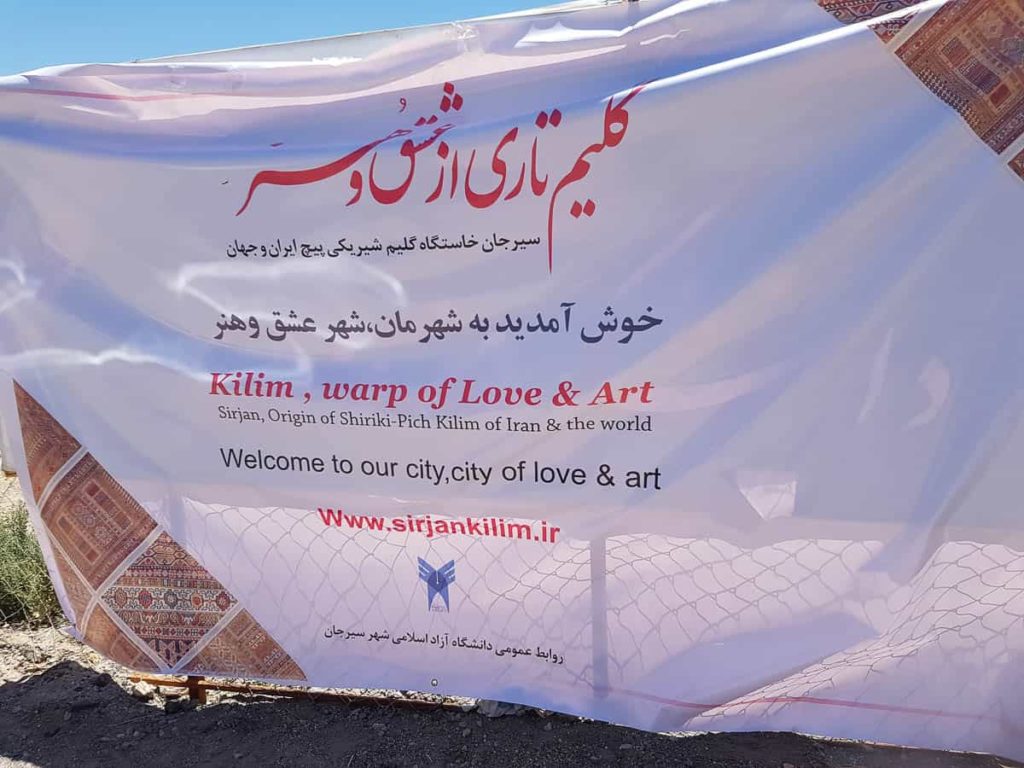Recently I had the privilege to visit the Iranian city of Sirjan, as part of a World Crafts Council delegation to assess their claim to be a World Craft City for Kilim, Shiriki-Pech to be precise. Iran has been very active in promoting its craft cities. Besides the honour and pride it invokes, the program has real benefits attached, such as improvements for health insurance and new education facilities. The kilims of Sirjan are quite exquisite and revered around the world. But still, this official recognition seemed an important affirmation of the craft to which they dedicate their lives.
On arrival, we found billboards around the city describing it as Kilim City – “Warp of love and art”. This branding made me think about the meaning of love in the presentation of traditional culture. The crowd that came out to greet us in Darestan seemed filled with pride in their craft. The street was lined with weavers demonstrating all the stages of the kilim. It certainly communicated that this was more than just an industry, but an intrinsic part of their collective identity.
Women in Iranian culture are often portrayed as beings of great sensitivity, associated with the flowers that abundantly adorn Iran, and inviting their protection by men. The delicate knotting required for kilim weaving seems a quintessential feminine activity. I found a very enthusiastic 10-year-old girl at the loom, as well as a 110-year-old woman who had been weaving for 103 years.
But there is a troubling paradox at work. As part of an official delegation, our discussions with the male leaders inevitably led to economic issues. The promise is that this “industry” can be developed further, increasing exports especially.
So is this love for sale? Are the men seeking to put the women’s devotion to their craft on the market? “Handmade with love” has become a marketing standard for products that offer some artisan credibility that distinguishes itself from mass produced industrial products. But as distance increases between producer and consumer, and handmade products are scaled up for international distribution, the danger of “brown-washing” increases, where images of smiling artisans feature on packaging with little meaningful engagement.
Why are consumers attracted to this magic ingredient – love? From an ideological perspective, the appeal reflects a deep unease with capitalism. In recent developments, financialisation leads to the ever increasing rule of money into hitherto sacred realms. The basic ethical impulse of hospitality is now something that can be bought and sold on Airbnb. Honour of learning becomes brand value in the modern corporate university. Monetisation offers greater freedom and distribution of goods, but it does also lead us to question whether anything is beyond its reach. Money also erodes trust, otherwise built up through a myriad of unpaid debts and favours that constitute a durable social and personal bond. But especially, money cannot answer the deep existential questions of how to frame a mortal existence. Donald Trump may say “Whoever has the most toys when he dies wins”, but the popular disdain for his values throughout most of the world testify to a need for something more.
A common critique of capitalism is that it is not sufficient for its own reproduction. To continue, it must draw upon the unpaid labour of women, who bear and care for children. It also requires the non-renewable bounty of nature to provide the resources necessary to continue. Capitalism has no answer to a planet whose atmosphere and terrain is rapidly filling up with the detritus of modern human life.
Given this big picture, we must ask ourselves whether buying the “love” embedded in a handmade craft product from a more traditional culture is any answer to this planetary dilemma. There’s always the danger that such “bandaid solutions” anaesthetise us from the grim reality.
But I think that this hardline position too readily leads to a cynicism that itself fails to engage with key issues. This critique is often more concerned with showing its knowingness about marketing ploys than offering an alternative. It is this romantic story of a culture pursued for its own sake which is important as a horizon beyond our own more transactional worlds.
Slavoj Zizek makes an argument for communism not because he believes in it as a system, but because it helps maintain a critical perspective towards the capitalism in which we are embedded. The love we imagine that is embodied in handmade objects may sometimes be a self-satisfying illusion, but we still need to believe in its possibility if a world beyond capital is possible.
Without denying the wish for economic improvement, we should choose to believe in love as the ultimate value. We need to keep this absolute value in mind when considering the prospect of “development”, which is often a cloak for external business interests. And we need to revere those masters of love, whose contribution to our world is at least as important as celebrities and financial tycoons.
To counter the commodification of this love, we should demand a transparency in the supply chain. We need to know more about the people whose hands labour over these objects, and they need to know about us. This is the goal of the Sangam Project and the Code of Practice for Partnerships in Craft & Design tries to enable this dialogue between producer and consumer.
I’m continually impressed by the dedicated artisans in all the World Craft Cities. As the Beatles, could have sung, “Craft is all you need…”




